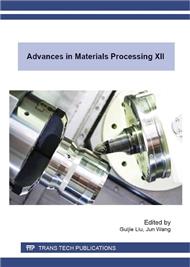[1]
A. Grohe, R. Preu, S.W. Glunz and G. Willeke, Laser applications in crystalline silicon solar cell production. In Proceedings of SPIE – The International Society for Optical Engineering, Strasbourg, 2006, pp.6197171-6197177.
DOI: 10.1117/12.663225
Google Scholar
[2]
Z. Wang, L. He, Y. Xie et al., Research on infrared laser scribing technology of single mesa diode wafer, Chinese Journal of Lasers, 38(2( (2011) 0203003.
Google Scholar
[3]
M. Gower, Laser microfabrication in industry - Perspectives from the past, present and future. In Proceedings of SPIE - The International Society for Optical Engineering, San Jose, CA, 2008, pp.6879021-68790215.
Google Scholar
[4]
M. Gower, Excimer laser microfabrication and micromachining. In Proceedings of SPIE - The International Society for Optical Engineering, Omiya, Jpn: Society of Photo-Optical Instrumentation Engineers, 2000, pp.124-131.
Google Scholar
[5]
J. Ren, M. Kelly, L. Hesselink, Laser ablation of silicon in water with nanosecond and femtosecond pulses, Opt. Lett. 30 (2005) 1740-1742.
DOI: 10.1364/ol.30.001740
Google Scholar
[6]
D. Wan, J. Wang and P. Mathew, Energy deposition and non-thermal ablation in femtosecond laser grooving of silicon, Machining Science and Technology, 15 (2011) 263–283.
DOI: 10.1080/10910344.2011.595324
Google Scholar
[7]
S. Manickam, J. Wang and C. Huang, Laser-material interaction and grooving performance in ultrafast laser ablation of crystalline germanium under ambient conditions. Proc. IMechE, Part B Journal of Engineering Manufacture. 227 (11) (2013).
DOI: 10.1177/0954405413492322
Google Scholar
[8]
V. Tangwarodomnukun, J. Wang, C.Z. Huang, H.T. Zhu, An investigation of hybrid laser-waterjet ablation of silicon substrates, Int. J. Mach. Tools. Manuf. 56 (2012) 39-49.
DOI: 10.1016/j.ijmachtools.2012.01.002
Google Scholar
[9]
H. Zhu, J. Wang, W. Li, H. Li, Microgrooving of Germanium Wafers Using Laser and Hybrid Laser-waterjet Technologies, Advanced Materials Research, 1017(2014) 193-198.
DOI: 10.4028/www.scientific.net/amr.1017.193
Google Scholar


